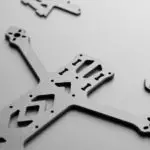It is inevitable to pick up soldering in FPV hobby if you want to build, repair or upgrade your drone. In this guide, I’ll teach you how to choose the best tools for FPV drone soldering.
Choose a soldering iron operating at least 60 W with adjustable temperature between 400-750 °F. Cartridge type bevel tips are more suitable for drone soldering. A good quality soldering iron costs you around $50. You should put in an extra budget for a good leaded solder (63/37), soldering flux, solder remover and a cheap tip cleaner.
Continue reading to learn more.
Why Do You Need a Soldering Tool?

At certain points, you might be thinking about sticking to an RTF/BNF drone instead of building your own drone. After all, soldering seems complicated and troublesome. Not everyone has done soldering before and even if we did, we are probably not really familiar with it.
However, you might find yourself holding the short end of the stick with that thinking as soldering will always come in handy no matter how much you try to avoid it. Say, for instance, your drone gets damaged during a critical race and your next heat is in twenty minutes. Do you forfeit? Do you go home and rethink your decision about entering this field?
Being able to at least repair a drone or change the broken parts is essential to avoid those kinds of situations. As such, you should consider grabbing a soldering tool and start to solder.
Soldering Gun vs. Soldering Iron
There are two common types of soldering tools in the market: the soldering iron and soldering gun. You should use a soldering iron instead of a soldering gun to build or repair your drone.
Soldering guns are best known for their power and ability to crank up the heat output in a few seconds, making them ideal for larger RC connectors and larger wiring projects.
However, this power also comes in bulky sizes, making it harder to do detailed work and accurate board adjustments. This is where soldering irons shine.

Modern soldering irons are small and comfortable to use, have temperature adjustment, and are, most importantly, affordable even for casual users.
If you are looking for a tool that you can use in your pit adjustments or personal customizations, soldering irons will provide you with both the efficiency and finesse necessary for the job.
Choosing the Right Soldering Iron
A quick internet search will provide you with thousands of available soldering irons in the market, and almost all of them will simply confuse you when you encounter them for the first time.
When choosing the right soldering iron to use for your project, you must think like you are choosing the right key for your keyhole at home, it needs to fit its purpose. There are 3 main points that you should consider when buying a soldering tool for your drone: power, temperature, and tip.
Power
Soldering any components would actively pull heat from your tool, making it necessary to keep generating heat through the heating element. To generate heat, you need energy, which is measured as power, in watt. As such, it is important to first look at the wattage, which directly translates to the capability in heating the tool consistently and effectively, before anything else.
Opting for a low-power soldering iron will take you more time to finish your soldering. If you would ask me, that is precious time lost that could have been used to fly your drone.
Note that numerous variables such as thermal efficiency, tip shape, and soldering technique would also greatly affect the amount of heat required by the soldering tip.
For drone soldering, you should go for 60 W or higher soldering iron. If budget is a concern, the bare minimum power required is 30 W. There will be a noticeable performance between 30 W and 60 W soldering iron, and that can have a direct impact on the quality of work.
Temperature and Range
A maximum temperature of around 750 °F (400 °C) degrees or higher is recommended for general-purpose use, but soft soldering would only require temperatures of around 400-750 °F (200-400 °C) degrees, depending on the type of solder being used.
Ideally, you want to be able to adjust the temperature of the solder iron so that you can efficiently solder different parts. But if that’s not available (or out of budget), choose one with higher maximum temperature.
For instance, if you are dealing with a bigger RC LiPo connector, you would want more heat; if you are dealing with a smaller part, a higher temperature would still work, but it is an overkill. In contrast, if your soldering iron can support only low temperature, you will have a hard time handling big components.
Tip
Choosing the right tip is essentially the main aspect of the keyhole metaphor. The tips are fitted into your soldering iron and serve as the point of contact between the heating element and the part being soldered. The four basic tip shapes are knife, bevel/hoof, conical, and chisel/wedge.
The knife tips are useful for point soldering and correcting the bridges. However, it can be a bit difficult to work on narrow spaces due to its wider surface. Meanwhile, the bevel tips can be used for both small and large surfaces, so it eliminates the need for constant tip changing.
The conical tip is infamous for its inefficient heating capabilities. Although it can help you limit the point of contact and ensure that the soldering is accurate, it quickly loses heat upon use and requires higher temperatures to effectively use it.
The chisel tip, on the other hand, is more “thermally efficient” in the sense that it can properly satisfy both accuracy and thermal efficiency with its shape and form.
Knife and bevel tips are the preferred choices for drone soldering. Some may prefer to use the conical and chisel tips, but this is simply a matter of personal preference.
Traditional soldering irons offer interchangeable tips that slide over a ceramic core. This technology has been far superseded by the cartridge tip technology.
In the newer generation of soldering irons, the heating element is built into the “cartridge-type” tips, which further reduces temperature fluctuations, and increases its temperature sensing capabilities. A solder iron with cartridge type tips requires lower wattage and temperature to achieve the same performance compared with their traditional counterparts. Because of the lower operating temperature, the lifespan of the tip increases.
If you are looking for the home run soldering iron in this day and time, the cartridge type tip will be the right option for you.
Soldering Iron Price
Purchasing a manageable and ideal soldering iron should not cost a fortune. A relief, right? Despite having numerous variants in the market, you can get your hands on affordable soldering tools that will do the job just as well as premium brand soldering tools.
Usually, a temperature adjustable soldering tool that has a power of around 60 W (fulfilling the ideal requirements of a great soldering tool) and correct tips can cost around $40-50. Some deals even include solder and flux.
I would recommend getting the NewBeeDrone tool kit that already include a soldering tool and accessories for drone building and repairing. If you just need a soldering iron and nothing else, Sequre SQ-D60 (affiliate link: GetFPV | Banggood) is an affordable option with decent quality.

Other Essential Purchases
Solder

Obviously, you need solder to solder. While it might not be as safe, leaded solder usually produces greater soldering because it has a shorter plastic phase, which simply means that it solidifies faster. The shorter the plastic phase, the shorter the time you need to hold the soldering joint in place, and subsequently the lower the likelihood of accidental movement that may cause a weaker solder joint.
A 63/37 (63 % tin and 37 % lead) solder is a good option as it has a very short plastic phase. A slightly cheaper option would be 60/40 solder, which offers similar performance.
As for the size, you need one with diameter below 0.04” (1 mm) to work with your drone.
Try to use a high quality solder instead of a cheap one. A higher quality solder makes soldering much easier by having a shorter plastic phase and lower working temperature. As such, it results in a way better soldering experience and works.
Soldering Flux
At a high temperature, the metal oxidizes easily. When oxidation occurs, the quality of the solder joint is hampered. The soldering flux is an acid or rosin-based compound that helps to prevent oxidation when soldering. On top of that, the soldering flux also acts as a cleaning agent to wash off impurities on the soldering surfaces to allow better bonding.
Soldering flux is usually built-in to the solder itself and you might think that it is not necessary to buy an extra one. However, if you are working at high temperature, the soldering flux may evaporate faster than it should. Signs of insufficient soldering flux include gray instead of silver solder joint and sticky skin on the molten solder.
It is always a good practice to add additional soldering flux if you are operating your soldering iron at a very high temperature.
Here’s a link to a soldering flux pen that you can get from GetFPV.
Solder Remover
You will need a solder remover to replace the existing components on your drone, or if you need to redo your soldering due to unsatisfied quality.
Essentially, after melting the solder on the solder joint, the solder remover can be used to either vacuum or absorb the molten solder. Using a paper towel or cloth instead is not advisable.
Tip cleaner
The flux being used during the soldering process may corrode the tip, resulting in damage and accumulative wear, making it unwise to ignore and leave dirty. Therefore, cleaning the tips of your soldering iron is an important process that helps the device last longer and allows for a better coating during use.
You can use a regular non-plastic damp kitchen sponge for cleaning purposes. Some people prefer using brass wool, arguing that a wet sponge creates thermal shock which can damage the tip. However, the benefit isn’t really significant. Use whichever suits you, but avoid using hard metal wool as it can damage the tip by wearing off the iron plating.
Final Thoughts
A good soldering tool is as important as a good soldering skill in building and repairing drones. By having a good soldering tool, your soldering work will improve a lot even if your skill is not perfect. Having said that, getting a good soldering tool is not a shortcut to avoid the need for improving your soldering techniques. You still need some basic skills to get the job done!
Now that you have your soldering tool, its time to build yourself a drone!


